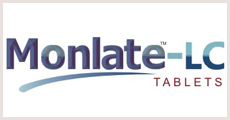COMPOSITION :
MONLATE- LC JUNIOR:
Each uncoated dispersible tablet contains:
Montelukast Sodium IP
Equivalent to Montelukast…………………….. 5 mg
Levocetirizine Dihydrochloride IP……………..2.5 mg
Excipients……………………………………….q.s.
Colour: Titanium Dioxide I.P.
Monlate- lc ff
MONLATE- LC :
Each film coated tablet contains:
Montelukast Sodium IP
Equivalent to Montelukast…………………….. 10 mg
Levocetirizine Dihydrochloride IP…………….. 5 mg
Excipients………………………………………..q.s.
Colour : Titanium Dioxide I.P.
DESCRIPTION :
MONLATE- LC/ MONLATE-LC Junior Tablets is a combination of
Montelukast Sodium & Levocetirizine Dihydrochloride.
Montelukast sodium is an orally active compound that binds
with high affinity and selectivity to the CysLT1 receptor.
Montelukast inhibits physiologic actions of LTD 4 at the
CysLT1 receptor without any agonist activity. It therefore
acts as a leukotriene receptor antagonist Levocetirizine,
the R-enantiomer of cetirizine, is a potent and selective
antagonist of peripheral H1-receptors. It has been demonstrated
by recent studies that the treatment of AR with concomitant
administration of an antileukotriene (montelukast) and an
antihistamine (levocetirizine), shows significantly better
symptom relief compared with the modest improvement of rhinitis
symptomatology with each of the treatments alone.
PHARMACOLOGY :
As MONLATE- LC is a combination of Montelukast and Levocetirizine,
the pharmacological properties of both the molecules are given separately.
Pharmacodynamics :
Montelukast:
The cysteinyl leukotrienes (LTC4, LTD4, LTE4) are potent
inflammatory eicosanoids released from various cells including
mast cells and eosinophils. These important pro-asthmatic mediators
bind to cysteinyl leukotriene (CysLT) receptors. The CysLT type-1
(CysLT1) receptor is found in the human airway (including airway
smooth muscle cells and airway macrophages) and on other pro-inflammatory
cells (including eosinophils and certain myeloid stem cells). CysLTs
have been correlated with the pathophysiology of asthma and allergic rhinitis.
In allergic rhinitis, CysLTs are released from the nasal mucosa after
allergen exposure during both early- and late-phase reactions and are
associated with symptoms of allergic rhinitis. Intranasal challenge with
CysLTs has been shown to increase nasal airway resistance and symptoms of nasal obstruction.
Montelukast is an orally active compound that binds with high affinity and selectivity
to the CysLT1 receptor. Montelukast inhibits physiologic actions of LTD4 at the CysLT1
receptor without any agonist activity.
Levocetirizine:
Levocetirizine, the (R) enantiomer of cetirizine, is a potent and selective
antagonist of peripheral H1-receptors. Binding studies revealed that levocetirizine
has high affinity for human H1 -receptors (Ki = 3.2 nmol/l). Levocetirizine has an
affinity 2-fold higher than that of cetirizine (Ki = 6.3 nmol/l). Levocetirizine
dissociates from H1 -receptors with a half-life of 115 ± 38 min. After single
administration, levocetirizine shows receptor occupancy of 90% at 4 hours and 57%
at 24 hours. The onset of action of levocetirizine 5 mg in controlling pollen-induced
symptoms has been observed at 1 hour post drug intake in placebo controlled trials in
the model of the allergen challenge chamber.
In vitro studies (Boyden chambers and cell layers techniques) show that levocetirizine
inhibits eotaxin-induced eosinophil transendothelial migration through both dermal and
lung cells. A pharmacodynamic experimental study in vivo (skin chamber technique) showed
three main inhibitory effects of levocetirizine 5 mg in the first 6 hours of pollen-induced
reaction, compared with placebo in 14 adult patients: Inhibition of VCAM-1 release, modulation
of vascular permeability, and a decrease in eosinophil recruitment.
Pharmacodynamic studies in healthy volunteers demonstrate that, at half the dose, levocetirizine
has comparable activity to cetirizine, both in the skin and in the nose.
Pharmacokinetic/pharmacodynamic relationship 5 mg levocetirizine provide a similar pattern of
inhibition of histamine-induced wheal and flare than 10 mg cetirizine. As for cetirizine,
the action on histamine-induced skin reactions was out of phase with the plasma concentrations.
ECGs did not show relevant effects of levocetirizine on QT interval.